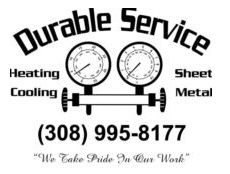
If you’re thinking about air conditioner installation in Holdrege, you should also be considering your new air conditioner’s SEER rating.
SEER is short for Seasonal Energy Efficiency Rating. In short, it examines how productive your air conditioner is at transforming electricity into cooled air. A bigger number signifies your air conditioner is more efficient, which is great for your energy costs.
However, there are a lot of varying options on the market for air conditioners. And a better SEER rating frequently is accompanied by a more expensive price tag. So, how can you determine which one is right for your house?
At Durable Service, we give you a free, no-pressure home comfort analysis. You can schedule one by contacting us at 308-995-8177. Our skilled air conditioner installers will work with you to help you pick the right air conditioner for your budget. Plus, they’ll also offer you a free, no-obligation estimate.
In the meantime, let’s review SEER ratings and how they can impact your family’s comfort. And your energy bills.
Why Do the SEER Ratings Even Matter?
In 2016, the federal government developed new SEER guidelines. New air conditioners are required to be at baseline 13 SEER in the northern United States and 14 SEER in the southeast and southwest. If you don’t know when you had your air conditioner put in or what its SEER number is, you can locate the sticker on the system outside your residence. If you can’t see the sticker, you can get in touch with us at 308-995-8177 for support.
If your air conditioner was installed in advance of that time, it’s likely much less efficient. Cooling technology has rapidly changed in the past few years, with huge breakthroughs in energy efficiency and smart home compatibility. Using your new air conditioner with a smart thermostat could help you spend less on electric expenses, because the thermostat can automatically regulate your temperature settings when you’re gone.
If your current air conditioner has a SEER rating between 8 and 10, getting a 14-SEER system could save you close to 30–50% on annual electrical expenses. Your savings depend on your air conditioner size and your temp settings.
Is the highest SEER Rating the Best?
An air conditioner with a better SEER rating will be more efficient at using electricity for cooling. The highest efficiency models, which can go as high as 26 SEER, carry ENERGY STAR® endorsement. This endorsement shows the air conditioner matches EPA requirements for energy savings and environmental conservation.
While ENERGY STAR air conditioners are frequently pricier, you’ll usually get the difference back over time through smaller air conditioning expenses. These air conditioners, which are frequently rated 16 SEER and better, need about 8% less electricity than other new models, according to ENERGY STAR.
One of the biggest differences between a 14 SEER and 16 SEER is variable-speed technology. A variable-speed air conditioner can work at a number of speeds. This refines comfort for your home while keeping your energy costs low. It can also keep temperatures and humidity more consistent, since it can run for longer without consuming a lot more power.
When adding a variable-speed air conditioner, you’ll have to check that your furnace or air handler is compatible. This is because your air conditioner relies on this system’s blower to disperse chilled air across your home. Furnaces only last for approximately 20 years, so if yours is getting old, we advise getting furnace installation at the same time so you can enjoy all the perks of your variable-speed air conditioner.
When you’re ready to replace your air conditioner, the cooling specialists at Durable Service are available to help. Reach us at 308-995-8177 to request your free home comfort analysis right away.

